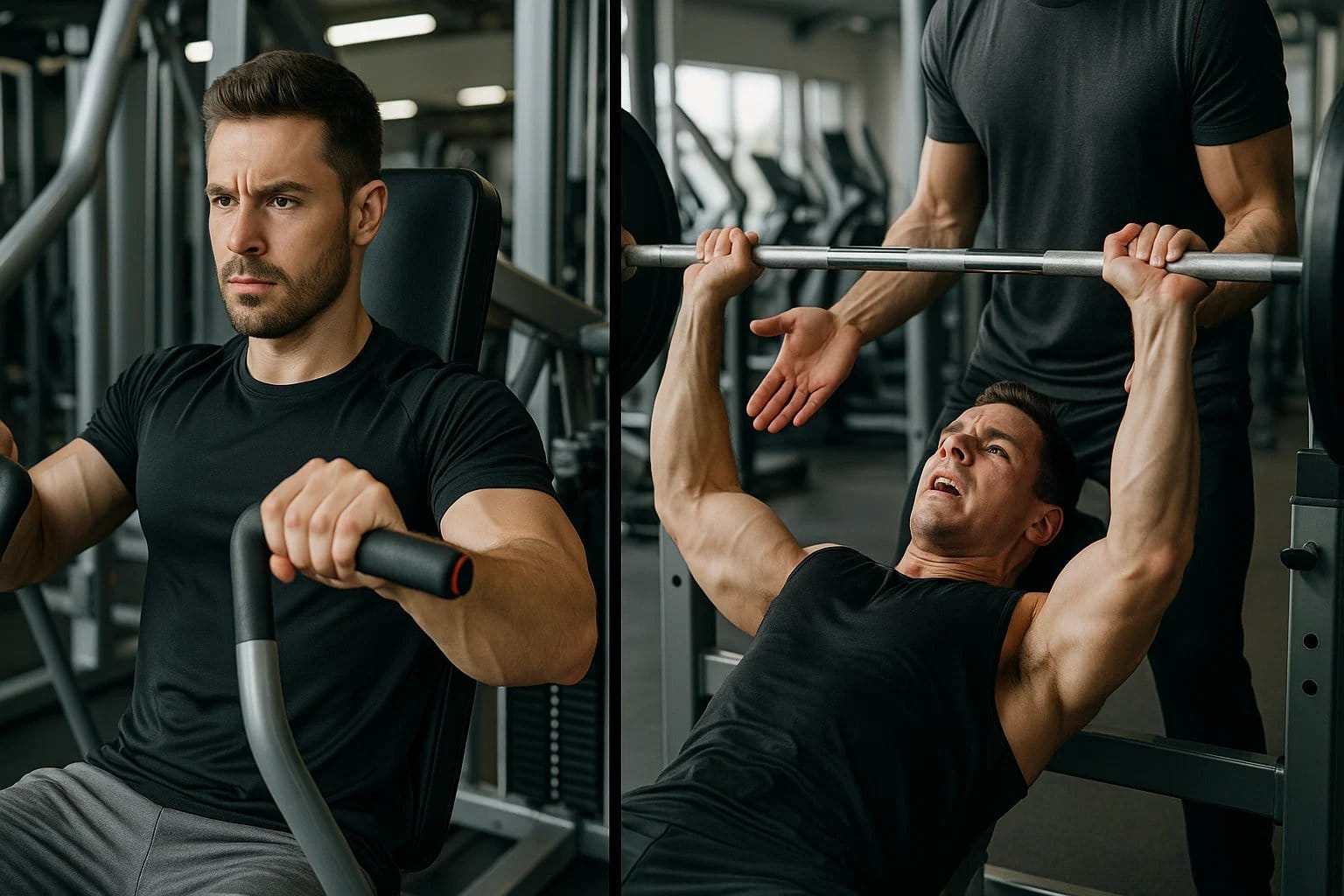How Long Should You Bulk For
This guide will help you find out how long you should bulk for. Learn whether men and women have different bulking needs before cutting.
How to optimize your bulk time and transform your body.
It’s bulking season everybody!
But when does the bulk end? We often prefer to feel our fluffiest in winter, then get shredded and let the abs show through once the weather starts to warm up.
But is this the optimal time to take our bodies through a transformation?
This article will explore the science behind bulk and cut cycles. Unpack what you can hope to experience both internally and aesthetically and find out how long is an optimal amount of time to bulk.

Bulking Basics
What is bulking? Bulking is a bodybuilding technique that refers to eating a caloric surplus to gain mass.
Usually, the aim is to gain muscle, however, by eating more total calories, you’ll gain some fat during a bulk as well.
Okay, time to get a little technical here. If you don’t love science, you can tune this part out. But it’s interesting, we promise. And the more you get familiar with what’s going on inside your body, the more you can nerd out about optimizing your workouts and diet.
After you work your muscles, the muscle fibers break down since your brain interprets work in your muscles as damage or injury. This is a good thing. Muscle stress causes the muscle fibers to fuse to repair themselves. The fusion of muscle fibers makes your muscles grow larger over time and through enough muscular work.
The muscle growth process is called “hypertrophy” (say that 5 times fast!). For muscles to grow, the rate of rebuilding needs to exceed the rate of muscle breakdown. To rebuild muscles, the body goes through a process called protein synthesis.
Your body stimulates this function through things like training volume (how many sets and reps you perform), protein consumption through your diet, muscle recovery, or how well your muscles build themselves back when you are not training. This is why it’s important to take adequate time for muscle recovery, especially on days when you lift heavy.
What do you Eat When You Bulk?
Theoretically, any foods that will increase your total daily intake of calories can help you bulk. After all, bulking is basically just the weight gain and calorie increase portion of the bulk cut cycle.
That being said, certain foods may make you feel better during your bulk and contribute more to the muscle you are looking to build. There is evidence that high protein foods can lead to better body composition.
One thing many weightlifters pay attention to is macros or macronutrients, or the main nutrients your body needs and that your body needs the most. These are protein, carbohydrates and fats.
Although any food you eat in surplus will cause you to gain weight, the ratios of food and macronutrients you consume can have different effects on your body composition and overall health.
In professional bodybuilding, an approximate ratio of 55-60% carbohydrate, 25-30% protein and 15-20% of fat is consumed by many athletes during the off-season and leading up to a competition.
Athletes' bodies vary a lot, however, and yours will too. But understanding macronutrients when it comes to your bulks and cuts can help you make more informed nutrition choices.
What are Bulk and Cut Cycles?
Think of bulking and cutting as a packaged deal. If you are doing one without the other, technically you are just losing or gaining weight independently.
The reason people pair a bulk with a cut or pair a cut with a bulk is to reveal the muscle beneath a layer of fat while maintaining size. If you just diet and reduce calories to lose weight, for example, you’ll whittle down your muscles with it.
And if you simply eat more without a cut after, the weight you gain may have more fat composition than you’d prefer. Bulking and cutting as a technique lets you get the best of both worlds if done correctly.
After a bulk to get big, most bodybuilders, whether professional or recreational aim to cut.
This doesn’t mean to cut down all the size you’ve gained. Cutting refers to a process where you reduce calorie consumption to cut down on body fat and weight while holding on to the muscle you’ve gained from your bulk.
Do bulking and cutting cycles vary for men and women? Let’s take a look.
How Long Should You Bulk For? — Female
For female weightlifters, bulking for at least 8 weeks is recommended, depending on the amount of muscle you hope to gain.
Keep in mind that women typically find it harder to lose fat than men do. This is true in general, especially after a big bulk.
So it’s important to make sure you have a cut plan in mind if you’re serious about packing on pounds beforehand. Dirty bulking— eating surplus calories quickly and with no limits on food type— can be more dangerous for women who are looking to cut after as well.
Although it may get you more mass, consuming a lot of high-calorie, high-fat junk foods can have negative health effects and result in stubborn fat.
Women generally have different physique goals in mind than men do when it comes to bulking. Although men often want to get bigger at all costs, as a woman you may be looking to gain lean muscle and build curves.
And although you can’t spot gain or reduce, what you do with your bulk is up to you! For example, see how you can transform your new gains into a healthy heart-shaped booty.
How Long Should You Bulk For? — Male
If you’re looking to pack on some pounds in hopes of gaining mass and eventually cutting down to look lean and big,
Men can also wrap up a bulk around the 8-week mark if preferred. That being said, it’s not always the most effective strategy, and you may want to extend the length of time that you spend in a bulk.
In fact, some lifters are even comfortable bulking for up to a year! If you’re a slim guy, a longer, gradual bulk to put on a lot of mass may be more up your alley.
Are all bulks created equal? There are a few opinions on the subject. Although weight loss means calories in, and calories out, at a bare-bones level, not every calorie is created the same.
What you’re eating and fueling your workouts with can drastically impact the way you feel and the energy you experience during workouts.
We broke down a few of the strategies you can take to optimize your bulk cycles and control the macronutrients you’re getting. Learn more by reading our companion articles: Lean Bulk, Lean vs. Bulk and Dirty Bulk.
Done with the bulking stage? Let’s see how you can take those newfound gains and get cut. Chisel your body into the spectacular stature of a Greek God with our targeted workout plan.
When Should You Stop a Bulk?
Although everyone’s body is different, there are a few body cues that can let you know it may be time to give up on your bulk. It may be time to slow down or stop your bulk when you notice these signs.
When you should stop bulking is more dependent on body fat percentage than length of time. As a general rule, men should wrap up the bulk between 15-20% body fat. For women, the 23-28% body fat mark is a good place to stop the bulk and begin cutting.
There are some body cues you should also be mindful of. These include:
- Feeling tired or sluggish
- If you notice significant increases in blood pressure
- If you are feeling sluggish or fatigued
- If your bulk is causing you to lack confidence or impacting your mental health
Bear in mind that all bodies are different. These percentages are loose guidelines and can depend on your age, training level, overall health, and genetics.
If you are making big changes to your diet or weight, it’s always a good idea to consult with a doctor or health professional.
Can You Bulk Without Gaining Fat?
Kind of, but it is unlikely to give you the results you’re hoping for. Building muscle means eating more calories and protein to fuel your workouts. Losing weight involves a calorie deficit (eating less), including fat.
By default, more food will equal some more fat and weight loss will involve at least some loss of muscle. The two goals are directly at odds with one another, so although it is possible to gain muscle and lose fat at the same time (we call this process body recomposition), it can often be more challenging.
Body recomp is especially hard if you have some fitness experience. It is most effective for:
- Fitness newbies who haven’t experienced major “first timer gains” yet.
- People coming back to the gym after a long break.
- Those who are overweight or obese and have significant weight to lose.
No matter what strategy you use: cut, bulk, or recomp, remember, your health always comes first.
Big Picture
These types of dietary changes can shock your system, especially if you are introducing a large increase or drop in calories. Talk to your doctor and a fitness professional about your general health and desired outcomes. They can help come up with an effective and results-based plan that is right for your physique goals without putting your health at risk.
To learn more about how nutrition plays a role in your body composition and overall health, get familiar with how supplements like creatine can impact your athletic performance. Check out Creatine: Monohydrate vs. Micronized, Can I Take Creatine Before Bed, and Does Creatine Expire? Find Out.
Bulk up your workout routine. Flex AI offers an all-in-one workout platform to help you learn new exercises, visualize your fitness journey and keep all your PRs in one place. We’ve made it simple to work on customized fitness plans or to introduce a little friendly competition to your fitness community by sharing exercises with your friends. Get started for free through the Flex fitness app.
References:
Antonio, J., Ellerbroek, A., Silver, T., Orris, S., Scheiner, M., Gonzalez, A., & Peacock, C. A. (2015). A high protein diet (3.4 g/kg/d) combined with a heavy resistance training program improves body composition in healthy trained men and women--a follow-up investigation. Journal of the International Society of Sports Nutrition, 12, 39. https://doi.org/10.1186/s12970-015-0100-0
Flann, K. L., LaStayo, P. C., McClain, D. A., Hazel, M., & Lindstedt, S. L. (2011). Muscle damage and muscle remodeling: no pain, no gain?. The Journal of experimental biology, 214(Pt 4), 674–679. https://doi.org/10.1242/jeb.050112
Krzysztofik, M., Wilk, M., Wojdała, G., & Gołaś, A. (2019). Maximizing Muscle Hypertrophy: A Systematic Review of Advanced Resistance Training Techniques and Methods. International journal of environmental research and public health, 16(24), 4897. https://doi.org/10.3390/ijerph16244897
Lambert, C. P., Frank, L. L., & Evans, W. J. (2004). Macronutrient considerations for the sport of bodybuilding. Sports medicine (Auckland, N.Z.), 34(5), 317–327. https://doi.org/10.2165/00007256-200434050-00004
Mettler, S., Mitchell, N., & Tipton, K. D. (2010). Increased protein intake reduces lean body mass loss during weight loss in athletes. Medicine and science in sports and exercise, 42(2), 326–337. https://doi.org/10.1249/MSS.0b013e3181b2ef8e
Venn B. J. (2020). Macronutrients and Human Health for the 21st Century. Nutrients, 12(8), 2363. https://doi.org/10.3390/nu12082363
Related articles


Get fit with Flex
Build muscle & lose weight fast for free.
Available on iPhone + Apple Watch





